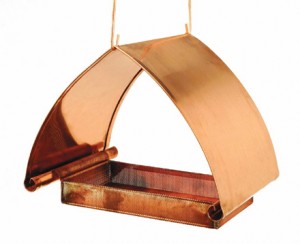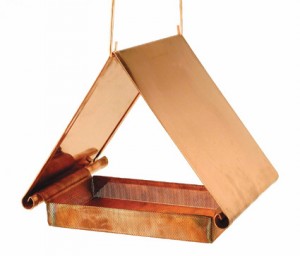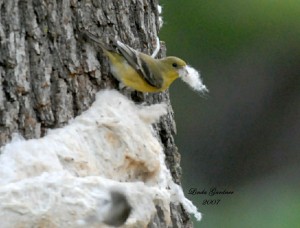-
Fly Thru Bird Feeders Do Double Duty
Fly Thru Bird Feeders are wonderful as they can accommodate such a wide variety of birds and foods. Anything from mixed birdseeds to suet, and dried fruit to meal worms can be fed in a fly thru feeder. Their practicality makes them an obvious choice if you are limited on the number of bird feeders you can have.
Copper Fly Thru Feeder Copper Fly Thru Feeder These innovative, hand crafted fly thu bird feeders can also be used as birdbaths. They are are made of solid copper and the trays are watertight. The unique design of the curved handles slides right into the roof. Birds and food are protected from the elements. These architectural, simplistic designs add beauty to any landscape, and the copper weathers over time to a lovely patina finish.
Totally functional art for your feathered friends that will last a lifetime.
-
Wood Birdhouses and Nesting Material
With the nesting season approaching for many birds, finding a suitable nest box isn’t always easy. Nesting birds drastically outnumber the available rental units! Having wood birdhouses in your yard greatly helps wild birds nest and raise their young, while also giving life saving shelter and protection from predators.
Goldfinch with Nesting Material In the photo above, an American Goldfinch gathers cotton nesting material for its nest construction. Various materials are used by different species of birds ranging from twigs, grasses, roots, and straw, to feathers, mud, bark, lichens and moss. Commercial nesting materials are available and are of tremendous value to the many types of wild birds. They consist mostly of cotton, feathers, strings, and other tiny shreds of fabrics. Dryer lint works well too! Help out your feathered friends with birdhouses and nesting material before the season starts, and you’re likely to see a “no vacancy” at your birdhouse.
-
The Week to Take Note at Bird Feeders
Great Backyard Bird Count The Great Backyard Bird Count (GBBC) takes place this month, specifically between February 13-16. This is a joint effort of the Cornell Lab of Orinthology and the National Audobon Society. The project links citizens with scientists in an effort to collect important data about backyard birds. This is the twelfth year the project has been running, and each year becomes more successful with participation of new backyard birders.
This week, take special note of who’s visiting your bird feeders and how many there are of each species. Jot down your info and simply report it online at www.birdsource.org/gbbc
An extensive data base is analyzed by scientists to better understand many aspects of wild bird populations, such as: migration patterns, habitat changes and range expansions.
So count your birds, and make your backyard count by participating in the
Great Backyard Bird Count!




